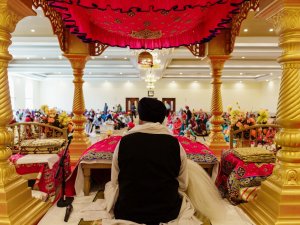By Sukhjit Kaur Khalsa and Lakhpreet Kaur
In the first article of our Sangat Harassment Series, “My Sangat Harasses Me,” we established that Sikh women are being cyber harassed frequently by Sikhs (this is not to say that Sikh men are not bullied but, the focus of this series is just on Sikh women.) The second article, “Why Does My Sangat Harass Me?” explored the question, “Why? Why are Sikhs harassing other Sikhs?” In our final article, Kaurs share what they need from the community to continue doing seva and we look at a Sikh response to harassment and online abuse.
IT’S NOT ALL BAD
We want to make it clear that all of the women who were interviewed for this piece said that for the most part, they receive overwhelmingly positive support from the panth and, negativity was at a minimum. But, there is still room for improvement.
Balmeet Kaur (pseudonym) says, “It’s been mostly positive. People are quick to support whatever it is we’re doing. ‘How can I get involved?’ ‘How can we share this?’ ‘How can I attend retreat and camp?’ That’s the general sentiment – of wanting to share the activities that are happening and replicating them elsewhere. 95% of the time comments on the internet have been positive.”
Sovereign Kaur (pseudonym) agrees, “Most people who see what I do are really supportive and appreciative. I’m always so grateful and thankful when I get calls and messages from people asking how they can join the next event.”
“Most of the time the Sikh community has been very supportive of my work and leadership”, says Leader Kaur (pseudonym). “And I feel this has improved as they have come to know me and appreciate my leadership and track record of impact over time. In particular, I have felt the love and support of other Sikh women and fathers with young daughters who they want to see them reach their full potential. There is a sense that if Sikh girls have more prominent and public Sikh role models, it would be a great thing for the community. As time progresses and I have a longer track record as a leader in the community, I find the interactions become more and more positive. I’m sure that’s a combination of the sangat seeing my full contributions and my own maturity over time.”
Jo Kaur, too, shares the positivity of activism in the community, “Overwhelmingly, we have such a strong and supportive community and I have received positive responses from fellow Sikhs. Activism and fighting injustice is in our blood, it’s what motivates so many in the Sikh community, girls and boys, men and women. In addition, it’s positive for a community that faces so much discrimination to see examples of Sikh activists openly and publicly fighting back against injustice, using a Sikh lens.” She believes there’s been tremendous work done by fellow Sikhs in increasing awareness about Sikh history and bringing to light the incredible acts of courage of the Sikh Gurus.
When Lakhpreet Kaur gets sweet notes from young Kaurs saying how they have grown to feel more comfortable in their Sikhi and how they no longer feel alone, all by reading Kaur Life’s articles – it makes her heart swell with love and it inspires her to keep doing the work she does. What also helps is a loving husband who tells her what she’s doing is valuable, worth the pain, and much needed in this world.
Despite all the hate, as an artist and activist, Sukhjit Kaur Khalsa can’t imagine being on any other path. “There is a lack of Sikh voices in the creative industry in Australia, let alone Kaur voices,” she said. “So, it feels necessary for me to continue so that others can also see that it’s possible to be a Kaur, activist and a full-time artist!” This is the message she gets not just from Kaurs but young Indian women, First Nations women, Anglo women – women from all cultures and backgrounds sharing their stories and feeling the solidarity in the sisterhood.
Being bullied in school and facing adversity is something that bonds Lakhpreet and Sukhjit together. They learnt from a very young age that if others aren’t going to stand up for them, they will have to take the lead and help the vulnerable and marginalized along the way. “Our Sikh history and the activism our Gurus and Sikh women displayed is what reminds us and inspires us to continue on this challenging path,” said Sukhjit. “However, we can’t do it alone.”
WHAT DO WE NEED FROM THE COMMUNITY?
The needs of Kaur activists, artists, and leaders is simple: have an open mind, do not be afraid to engage in dialogue, be compassionate, and be respectful.
RECOGNIZE DIVINITY IN ALL
Lakhpreet shares her needs when it comes to respectful online spaces, “The Kaurs and Singhs who choose to write on Kaur Life or share their thoughts on Sikhi are opening their hearts and making themselves vulnerable to the entire world. It takes a lot of strength and courage to put yourself out there and I would hate for them to feel that sharing their thoughts was a bad idea once they read the nasty comments. I don’t want a couple of mean commenters to deter writers from adding to the larger Sikh dialogue. Every time I go publish a piece, I always wonder, ‘Will the writer regret having submitted this article?’ At Kaur Life, we believe it is valuable, important, and imperative to allow all sides of an argument to be heard. But it is destructive and not helpful for people to make personal attacks, or to write messages with extremely angry, dogmatic tones. Even if someone is making a valid point, the angry tone and rude framing is hurting their argument and causing others to tune them out.”
“If someone has written something ‘wrong,’ I personally feel the best way to react is with love and patience. Why not use the comments section as an opportunity to help people understand a new point of view? Help elevate the writers, instead of pushing them away or making them feel bad. I find that criticizing someone rarely, if ever, helps someone become a ‘better’ Sikh or change their view point.”
“My need from the community: I am asking for all of us to be a little nicer. Please share your comments, your disagreements, and your dissenting opinions but, do so in a respectful manner. Present opposing viewpoints civilly and respectfully disagree. When engaging in online discussions try to keep in mind what a bhai sahib once told me, ‘The Divine is in everyone so, when you criticize a person, you are criticizing the Divine.’ Recognize, the Divine within the person whom you are commenting to. Just because we aren’t face-to-face with them, doesn’t mean they can’t feel the sting of our word, and it doesn’t exempt our keystrokes from the Guru’s teachings of respecting everyone.”
“The Internet is a tool, just like any other,” Lakhpreet continued. “A hammer can be used to hit someone over the head or it can be used to build a house. The internet can be used to tear people apart or bring them together. There are so few of us Sikhs in the world that we should be leveraging the Internet to bring us together; we should be using it to support each other and help us overcome the feeling of isolation many of us may feel living in the West. One may not see a Sikh face all day, but when I come home and click on Kaur Life, I can hear Sikh voices. We should use the Internet to reconnect with our roots and our culture. In The Sangat Flourishes in Cyber Space, Dr. I.J. Singh talks about the beauty and power of building sangat over the Internet and I, like him, truly believe that it has a lot of power for good.”
POSITIVE CONTRIBUTIONS TO THE WORLD
Sukhjit agrees, “Would you like to perpetuate hate or love? How would it make you feel hearing those words that you type in your comments? Do you need a platform to share your opinions? If you feel the need to complain about something without a solution or action plan, and you aren’t willing to do anything positive or creative to contribute then maybe have a think about who your berating comments will benefit. Maybe negativity isn’t serving you either. Start your own Youtube channel, put your thoughts out there in the world via poetry, song, dance, articles, visual art. The possibilities are endless. Take the time to engage in seva and perhaps you’ll understand the labour of love, bravery and vulnerability that goes into being an artist, activist, writer, and creative.”
BE GOOD ROLE MODELS
Balmeet Kaur said that as a sevadar, she wants to have role models and inspirational examples of people who are doing great work for the community “I would like a network of Kaurs in North America who are doing seva and who are curious how their seva intersects with their Sikhi. It’s lonely work. I want every Kaur who’s doing the lonely work to feel like she is supported and growing and not sacrificing herself for no reason. As the compulsive givers we run into that a lot.”
FOCUS ON THE FUTURE
Leader Kaur says she needs the community to focus on the outcomes we want to see for future generations. “If we concentrate on aspiring to live a Sikh way of life and serve humanity, the gender of any leader won’t matter. We also need those who long for the limelight to stop and reflect – they need to leave some oxygen for others to breath. Sometimes being a leader doesn’t necessitate standing out front – it requires clearing a path for others. As a community we really need to work on demonstrating humility and that will go a long way to living the equality we always highlight to non-Sikhs as central to the Sikh faith.”
SPACE TO GROW
Sevadar Kaur (pseudonym) emphasizes the importance of being generous and understanding that we are all at different points in our Sikh growth. The more support and space one is given she says, the more people want to grow. She believes part of being a strong Sikh is not judging others. Some people say, “The Gurus taught us to have sangat and we are supposed to call out one another.” For her, using the phrase “to call out” is not the right language. “I don’t believe the Gurus wanted us to ‘call each other out’ but rather to lead by example and inspire people. When Guru Nanak Sahib started throwing water towards his crops, he wasn’t doing it in judgement way. Instead he inspired curiosity and conversation.”
Creating spaces to grow and explore Sikhi are essential in developing a robust and confident panth. In response to the dangerous work and often lonely work that Sikh women activists engage in, Valarie Kaur, the Sikh Coalition, Auburn Theological Seminary, Loyola Marymount University, and Revolutionary Love Team created the Mai Bhago Leadership Circle.
“[Activism] is unsustainable without a strong community of support. This is what led me to the vision behind the Mai Bhago Leadership Circle — a leadership retreat that provides sisterhood, support, and training for Sikh women justice leaders. Led by an incredible team of Sikh women activists, we have brought Sikh women activists together for two retreats in a pilot program and are now planning to launch the program publicly in the future,” said Valarie Kaur. “Through this program and so many other initiatives by young Sikh Americans across the country, I am hopeful that our generation is clearing the way for many more Sikh women and girls to lead us as modern-day women warriors in the years to come.”
BRING KAURS & SINGS TOGETHER
Harleen Kaur’s wish is to see more investment from Singhs and more compassion towards Kaurs who are brave enough to speak up about the gender inequality within the community. “I often see that, even in relatively ‘progressive’ Sikh spaces, there are Singhs who shame Kaurs for being angry or having a certain tone when responding to oppressive ideas. There needs to be a higher understanding of why this frustration is there and that it has often taken years for this Kaur to even gain the courage to speak up about the sexism and misogyny she faces in the first place. Also, Singhs need to take it upon themselves to become better allies to Kaurs and challenge misogyny—whether it’s social media accounts shaming Kaurs for dressing or acting a certain way or interpersonal conversations that joke about women in a stereotypical or harmful way. Again, while this takes courage, men are at a position where they can engage with these conversations in a safer manner because of their male privilege.”
HOW TO DEAL WITH HARASSMENT, BULLYING & ABUSE
For those who have read our three part series, you too may have experienced harassemnt in the Sikh community for being a Kaur/Kaur activist. Fear not, we have our strong team of Kaurs who have shared their advice to help you out.
BE HOPEFUL
Balmeet Kaur believes the way to tackle harassment and buylling is to keep holding onto hope and to remember that what you’re doing is feeding into the community’s psyche. She urges, “If you’re hopeful and maintain a lens that’s grounded in Gurmat and Sikh values then it’s easier to ignore the micro-aggressions and carry on what you’re doing with more passion, love and chardikala than before. The only way we can push the needle within the community is if we do that hard work. There are a lot of obstacles and internal battles (within the community and within ourselves) but hold onto that hope; you’re not the one doing the seva but Guru has given you the opportunity to step up and make a difference.”
SEPARATE SIKHS FROM SIKHI
Harleen Kaur was confused for a long time because she conflated the beliefs and opinions of the Sikh community with Sikhi. “Once I was able to separate my Sikhi from what other Sikhs said about me, I could develop a stronger sense of personal identity separate from their critiques and focused on my understanding of gursikhi jeevan (Sikh way of life) and structural oppression. While it has nevertheless been draining, I have found my sweet spot in educating more Singhs about gender equality to be my older and younger veerjis—blood-related, camp-related, or otherwise—because the love they feel for me as their younger sister and their ability to see me as a strong-minded individual. While my peers have often let me down in these conversations, the age difference often creates a new dynamic where each person can simply appreciate the humanity and truth in the other person and allow them to have conversations without ego or anger. Find these people in your life and save your energy for them; don’t waste your time on people who are not even willing to acknowledge your humanity and worth as an equal creation of Vaaheguru.”
DISAGREEMENT VS NEGATIVITY – KNOW THE DIFFERENCE
Jo Kaur brings up a valid point about distinguishing between disagreement and negativity when it comes to assessing challenging responses. She’s received countering viewpoints on issues, which she finds to be wonderful and encouraging, and have helped her to learn and evolve as a person and activist. “I think it’s important for us to dialogue with well meaning fellow activists because we need each other. If one of us gets something wrong, let’s dialogue and explain, and not write the person off. Let’s give fellow allies the benefit of the doubt.”
GET ARTSY
We all have our coping mechanisms and for many Kaurs, the arts are the way to go. Sarangi player, Amrit Kaur Lohia encourages people to engage with art, create art, and read history that is not tainted with ideologies and political agendas. “Kashi House publications are great for this as they present history and archival material as it is and leave you to do the critical thinking and make judgements,” she said.
She added, “Be kind. Stop arguing about who and what is right, it’s not about that. Don’t turn words of love and devotion in scripture into ammunition for arguments sake. Don’t just accept knowledge that is passed down. Build your own relationship with the Divine. Be aware of contradictions, double standards, rituals, and symbolism. Be committed to personal growth and learning. Always go back to the basic teachings of Guru Nanak Sahib. Sing your heart out.”
FIND YOUR PURPOSE
Ultimately, Lakhpreet Kaur believes we need to focus on our “why” and our reasons for serving. “Once I was clear about my purpose and my seva, I kept reminding myself of that on bad days.” In addition, she states that finding ways to cope is helpful, “This could include, finding people to confide in, engaging in rejuvenating activities, and developing our understanding of self and self worth outside of extrinsic things or other people.”
DEVELOP TOOLS
Ek Ong Kaar Khalsa Michaud shares the difference between her private and public tools she uses to deal with harassment. Privately, she practices Kundalini Yoga meditation, journaling, and discussing experiences with other. Finding constructive responses, rather than reacting is how she responds. And if the bullying is intense enough and pushes her into some kind of PTSD reaction, she turns to professional therapy.
“Publicly, however, I rely on one basic protocol: grace and diplomacy. Standing up for myself without attacking back or getting negative. Staying silent if it is a wiser course of action. Focusing on the positive work that the Guru blesses me to do in this life, rather than letting the bullying pull me off-course. The bullying may pull me off-course for a while, but I take steps to self-correct. Creating dialogue where dialogue may be possible. But not insisting on it if dialogue is not, in the moment, possible.”
WHAT IS THE SIKH RESPONSE TO BULLYING?
Ek Ong Kaar Khalsa Michaud has some enlightening thoughts.
“The fascinating truth about Guru Nanak’s life is that he and all the Sikh Gurus did everything they could to dismantle the dominance hierarchy. They abolished the caste system. They modeled inclusive, tolerant social behavior among different religions. The spiritual throne never passed to the first born son of the Guru. Women played a significant role in the succession and development of the panth. Women were teachers, warriors, and leaders.
The whole point of the social-spiritual revolution of the Sikh Gurus was to shift humanity away from the dominance hierarchy, which excluded all women and the majority of men from power. They shifted to a more community-spirited social order, including dialogue across various groups and factions; and a unique distribution of economic and political power that sought to minimize the separation between the haves and the have-nots.
Yet, almost 550 years after Guru Nanak Sahib’s birth, the manifestation of that type of society still eludes us.
On the contrary, today, we have many Sikhs who don the garb of the 10th Master, Guru Gobind Singh, not because they represent the value, character, and spirit of the Khalsa. But simply because they need to look a certain way in public in order to compete in the Sikh community dominance hierarchy.
So it’s a deep and difficult issue.
As a woman who is in the public eye to some extent, and who has to face bullying regularly, I can only share what has worked for me.
Know your values.
Know your goals.
Know your negotiables and your non-negotiables.
Keep your grace.
Have a daily spiritual discipline to work things out.
Have a support system for when the bullying gets overwhelming.
Practice diplomacy.
And don’t feed the dominance hierarchy. Don’t allow your voice, your energy, your talents to get trapped in the aggressive games of submission and dominance. Fight to create a different kind of social structure where it doesn’t matter who is on top.
It is the distance we travel on the path our souls choose to walk that matters in the end, after all.”
That concludes our Sangat Harassment series. We would love to hear about how you deal with, cope with, and address harassment and cyberbullying. What are you thoughts on a Sikh response to harassment? How do you think the Sikh panth should respond to harassment?





